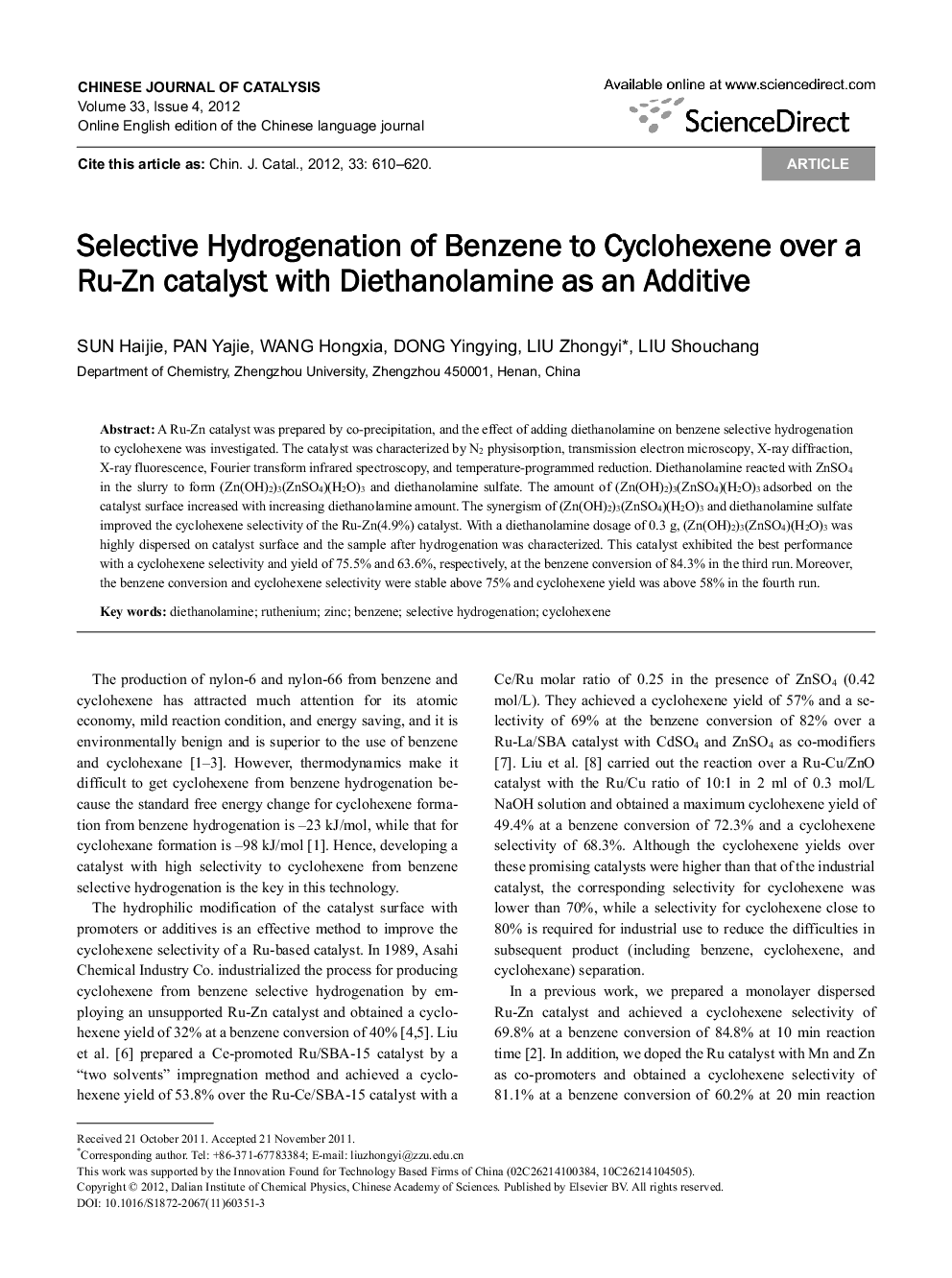| Article ID | Journal | Published Year | Pages | File Type |
|---|---|---|---|---|
| 59513 | Chinese Journal of Catalysis | 2012 | 11 Pages |
A Ru-Zn catalyst was prepared by co-precipitation, and the effect of adding diethanolamine on benzene selective hydrogenation to cyclohexene was investigated. The catalyst was characterized by N2 physisorption, transmission electron microscopy, X-ray diffraction, X-ray fluorescence, Fourier transform infrared spectroscopy, and temperature-programmed reduction. Diethanolamine reacted with ZnSO4 in the slurry to form (Zn(OH)2)3(ZnSO4)(H2O)3 and diethanolamine sulfate. The amount of (Zn(OH)2)3(ZnSO4)(H2O)3 adsorbed on the catalyst surface increased with increasing diethanolamine amount. The synergism of (Zn(OH)2)3(ZnSO4)(H2O)3 and diethanolamine sulfate improved the cyclohexene selectivity of the Ru-Zn(4.9%) catalyst. With a diethanolamine dosage of 0.3 g, (Zn(OH)2)3(ZnSO4)(H2O)3 was highly dispersed on catalyst surface and the sample after hydrogenation was characterized. This catalyst exhibited the best performance with a cyclohexene selectivity and yield of 75.5% and 63.6%, respectively, at the benzene conversion of 84.3% in the third run. Moreover, the benzene conversion and cyclohexene selectivity were stable above 75% and cyclohexene yield was above 58% in the fourth run.
摘要采用共沉淀法制备了 Ru-Zn 催化剂, 考察了二乙醇胺的添加对 Ru-Zn 催化剂上苯选择加氢制环己烯性能的影响, 并采用 N2 物理吸附、透射电镜、X 射线衍射、X 射线荧光、傅里叶变换红外和程序升温还原等手段对催化剂进行了表征. 结果表明, 二乙醇胺可以与浆液中 ZnSO4 反应生成 (Zn(OH)2)3(ZnSO4)(H2O)3 和硫酸二乙醇胺盐. 随着二乙醇胺用量的增加, 化学吸附在催化剂表面的 (Zn(OH)2)3(ZnSO4)(H2O)3 增多, 它与硫酸二乙醇胺盐的协同作用提高了 Ru-Zn(4.9%) 催化剂上苯选择加氢生成环己烯的选择性. 当二乙醇胺用量为 0.3 g 时, (Zn(OH)2)3(ZnSO4)(H2O)3 在 Ru-Zn(4.9%) 催化剂加氢后样品的表面高度分散, 反应性能最佳, 循环使用第 3 次时苯转化率为 84.3%, 环己烯选择性和收率分别达 75.5% 和 63.6%; 使用至第 4 次时, 反应 25 min 时苯转化率和环己烯选择性仍可达 75% 以上, 环己烯收率为 58% 以上.
Graphical abstractWith a diethanolamine dosage of 0.3 g, (Zn(OH)2)3(ZnSO4)(H2O)3 was promoted to be highly dispersed on a Ru-Zn(4.9%) catalyst and ZrO2 particles, and this gave a cyclohexene selectivity and yield of 75.5% and 63.6%, respectively, at the benzene conversion of 84.3%.Figure optionsDownload full-size imageDownload as PowerPoint slide
